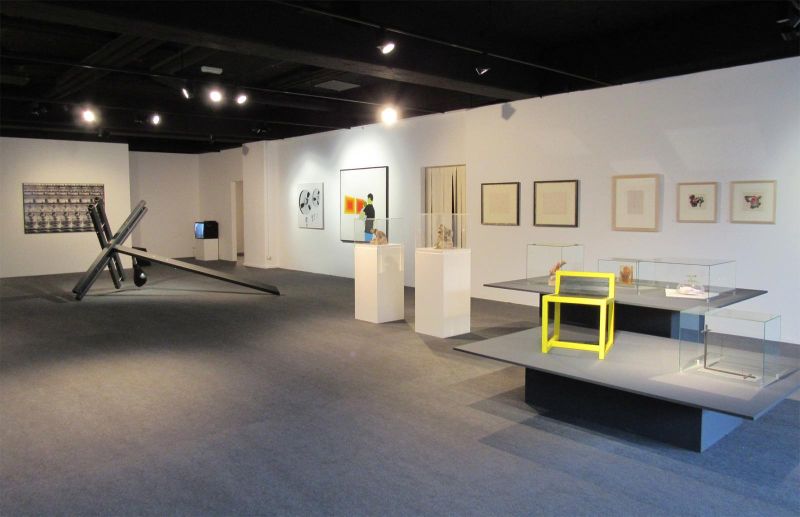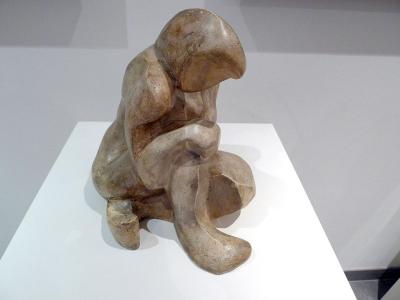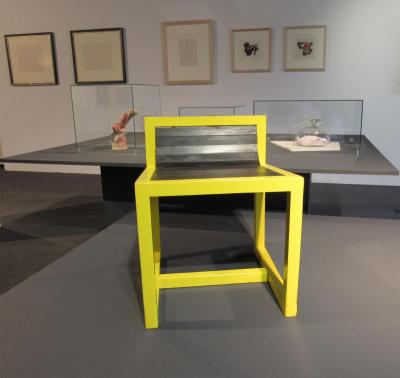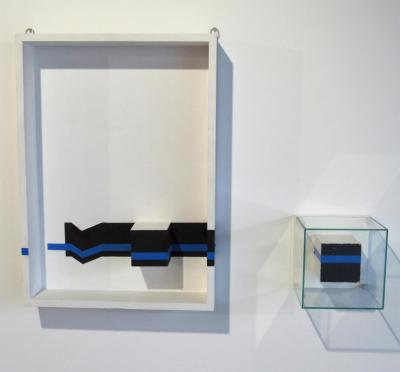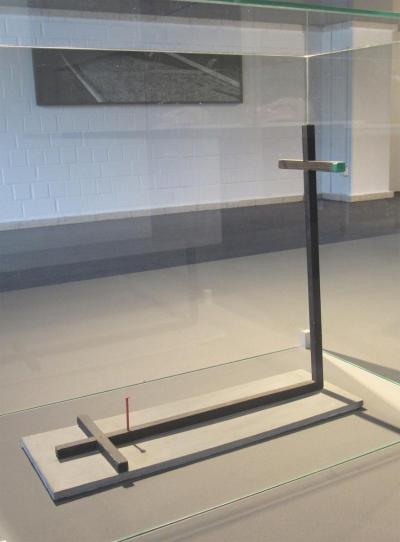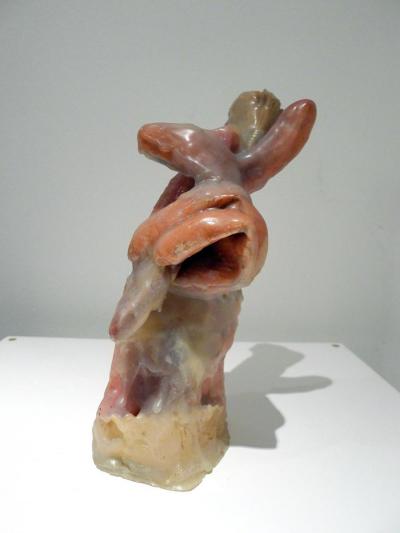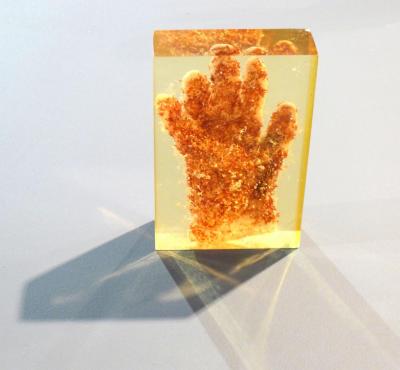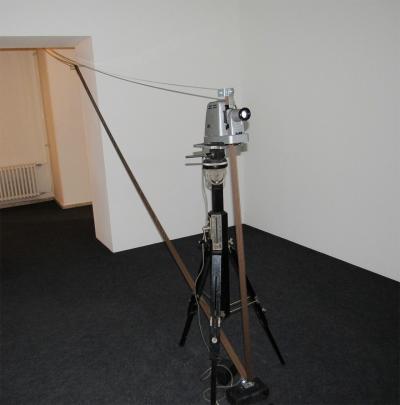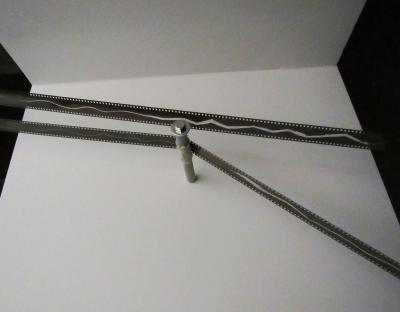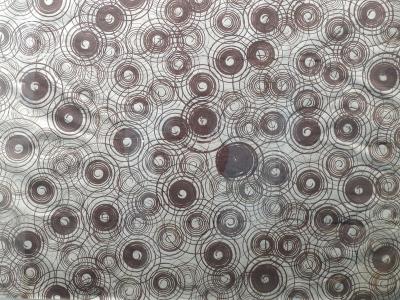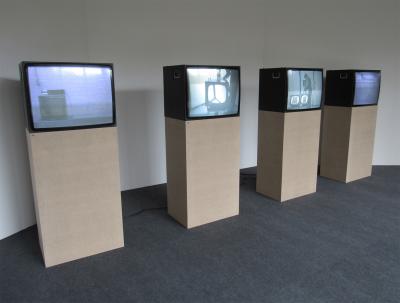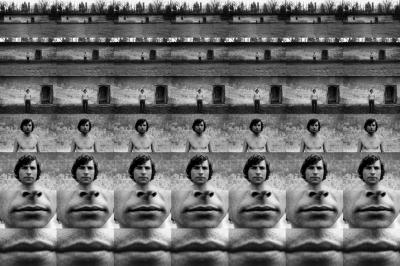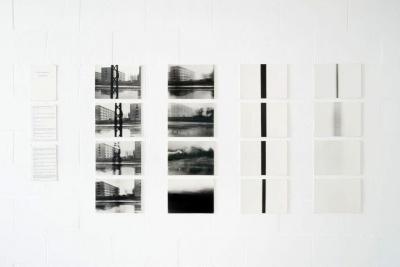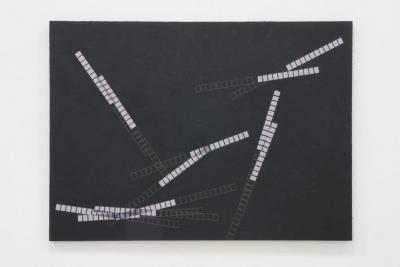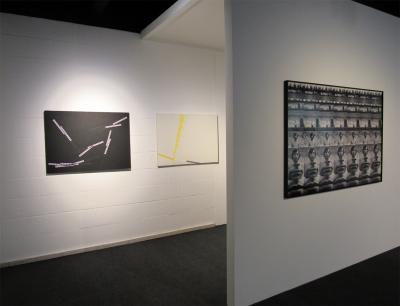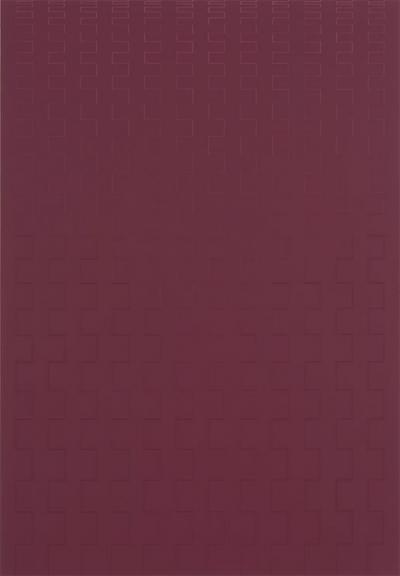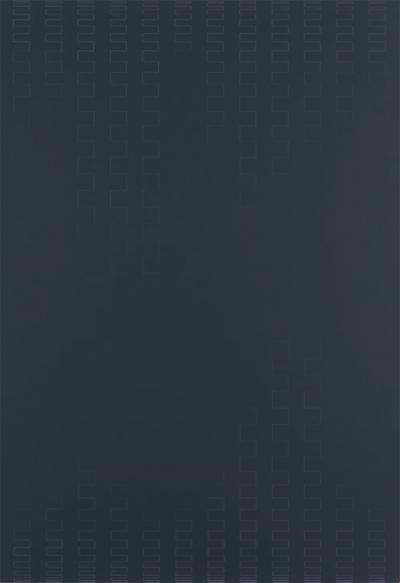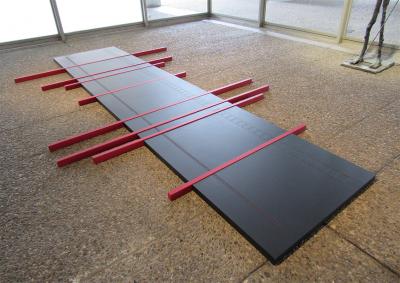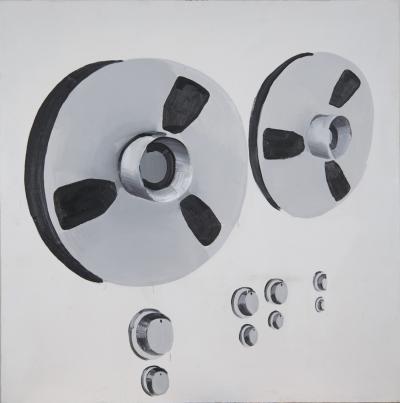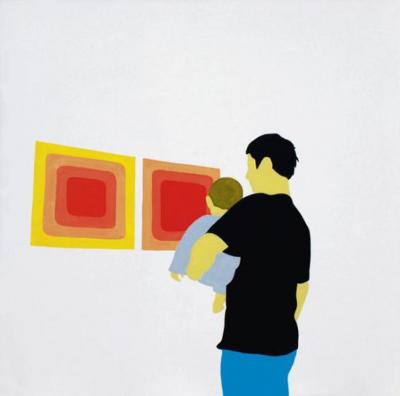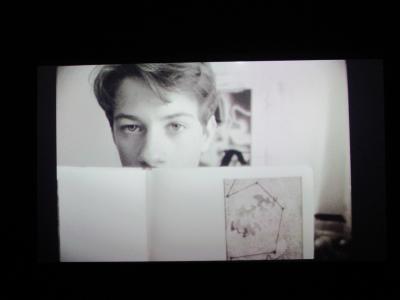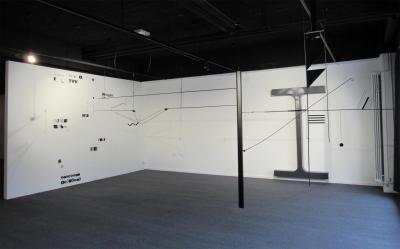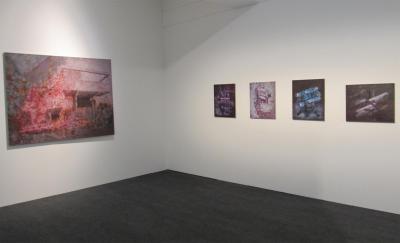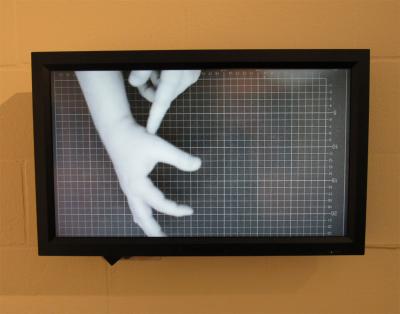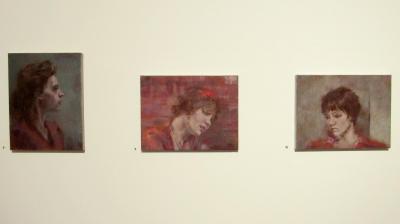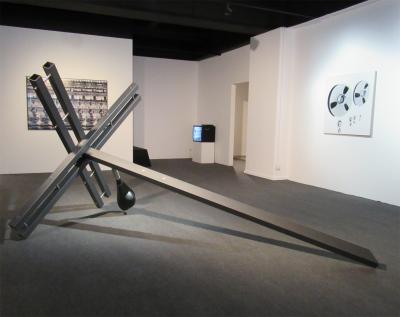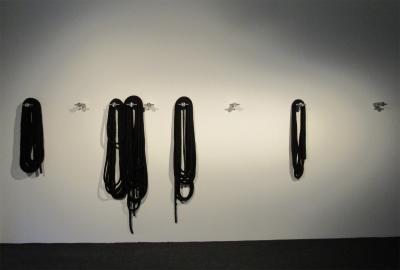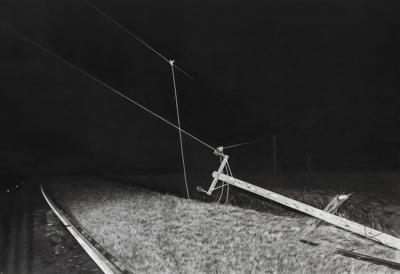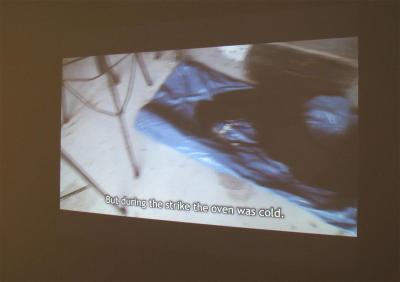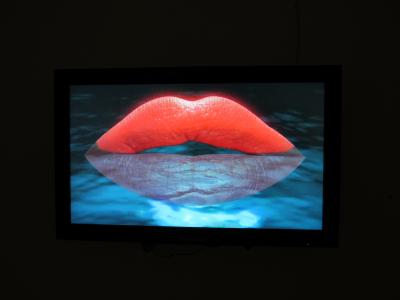Across the Generations – Polish Art in Marl 6th March to 12th June 2016
Mediathek Sorted

The works of the older generation of Polish artists in the exhibition, all of which come from the Jerke collection, laid down the lines for the development of the following generations of artists. Here two female “Nudes” by Katarzyna Kobro (1898-1951), gypsum sculptures between 20 and 30 centimetres high made in 1948 (ill. 1), proved to be a sensation, at least for German visitors: for Kobro is internationally well-known for her constructivist “spatial compositions” (Kompozycje Przestrzenne) from welded and painted steel, derived from 1920’s Russian Suprematism. However in 1925 she started with a series of small groups of sculptures, all of them Nudes, which her husband Władysław Strzemiński (1893-1952) judged to be similar to works by August Zamoyski, “only better”. Some of them are now kept in the art museum in Łódź (Muzeum Sztuki w Łodzi). In 1948 shortly before Kobro gave up working as an artist, she created another series of similar “Nudes”, whose expressive power and dynamics reveal her Cubist roots. Both the works shown here were part of this series and now also belong to the Jerke collection. The exhibition also showed two figurative drawings by Władysław Strzemiński, which were made at the end of the 1930s when he had long since given up “Unism” in favour of concentrating on biomorphic forms with clear outlines. His “Yellow Stool” (1948) can almost be seen as a gesture of homage to his wife’s constructivist works (ill. 2).
Although this exhibition was basically dedicated to a core of older artists, Edward Krasiński (1925-2004) and Alina Szapocznikow (1926-1973) really belong to the following generation, for both began their studies after the end of the Second World War. Krasiński “is one of the few authentic innovators in Poland”, said Wojciech Skrodzki in a standard work on “Contemporary Polish Sculpture” published in 1977. Krasiński is still widely regarded as one of the most important protagonists of Polish neo-avant-garde in the 1960s and 70s. On the one hand his artistic roots lay in Polish constructivism, co-founded by Henryk Stażewski (1894-1988), with whom he lived until the latter’s death. On the other hand he belonged to the Kraków Group (Grupa Krakowska II) founded in 1948 around Tadeusz Kantor (1915-1990), in whose happenings he participated in the mid-1960s. His internationally known trademark was the light blue “Scotch” adhesive tape that, in 1968, he began sticking to walls and objects, using it in exhibitions, or winding it around people and trees. He also used it to create constructivist objects like those in the Jerke collection (ill. 3). True, his sculpture, “Cross” has a stringently constructivist feel, but it really belongs to a group of objects comprising the “Spears” in the 1960s and the “Crosses” at the beginning of the 1980s. Like the objects and installations by Kantor, they are loaded with meanings and intended to “liberate energies” (ill. 4). Alina Szapocznikow, who survived five ghettos and concentration camps, studied sculpture in Prague and at the Ecole des beaux-arts in Paris. In 1951 in Poland she began to make strongly abstracted figurative sculptures. In 1963 she returned to Paris where she joined up with the Nouveau Réalisme circle around the art critic Pierre Restany and the artists, Arman, Daniel Spoerri and Niki de Saint Phalle. After that she dedicated her artistic energies to casts of body parts in polyurethane into which she inserted everyday objects. In 1968 she was diagnosed with cancer and from that time onwards her work dealt with disease symptoms and relics of our own body. Shortly before she died in 1973 she created the object “Fajrant” (English: At the End of the Working Day) that is now in the Jerke collection (ill. 5).
In this exhibition the leap to the middle generation was shown by the work standing next to it. “Object 3”, an upright glove poured in epoxy resin was made by the 19 year younger Teresa Murak who was born in 1945 (ill. 6). By contrast with the piece by Szapocznikow, Murak’s work is not so much an artistically designed object as a conserved document of a process. Murak, who studied at the Academy in Warsaw from 1970 to 1966 under Jan Tarasin amongst others, began working with cress seeds in 1972, which she stuck on pieces of clothing on her own body – or in this case on a glove used for “Object 3” – and brought to germination, thereby helping nature to develop a new form of expression. For Poland Murak represents the transition from object art to process art, and the introduction of new materials at the beginning of the 1970s.
The middle generation in the exhibition was also represented by Józef Robakowski (*1939) and Ryszard Waśko (*1947), both of whom work in the areas of experimental film and videos. At the start of the 1970s they also pursued studies in film together at the State School of Film, Television and Theatre in Łódź Państwowa Wyższa Szkoła Filmowa, Telewizyjna i Teatralna Im. Leona Schillera w Łodzi). Robakowski is one of the key figures in Eastern Europe video art. In Germany his works, which can be seen in places like the Zentrum für Kunst and Medientechnologie (ZKM) in Karlsruhe and the Neuer Berliner Kunstverein, analyse the language of media art. His artistic approach is strongly influenced by constructivism and the neo-avant-garde of the 1970s. The exhibition showed one of his best-known films “From My Window”, a chronicle of everyday scenes taken from the kitchen window in his flat in the centre of Łódź starting in 1978. Here the tension between the unchanging locality and the continuous political and social changes makes everything seem absurd. He stopped this work in 1999 when the city administration decided to build a five-star hotel on the place he had been filming (ill. 7). In addition the exhibition also showed one of his 35mm film installations, in which one of the lines inserted in the film snakes around the projection on the screen whilst the film itself is diverted in different directions on several occasions and moves like a snake through the room (ill. 8a, b). These and also a work entitled “Termogram” (2001) from a series of works on heat sensitive paper that were created over several years (ill. 9) bear witness to Robakowski’s simultaneously constructivist and playful approach to media art.
Waśko was one of the central artists in the exhibition: he had 13 works which covered a huge range of his artistic activities. The earliest works on show came from his time at the State Film University in Łódź 1970-1975, during which he was also a member of the Workshop for Film Form (Warsztat Formy Filmowej), one of the most important groups of Polish artists in the 1970s, where painters, filmmakers, critics, writers, philosophers and academics concerned themselves with experimental films and multimedia. The films he made after 1972, “Space out of”, “A Corner 1-2”, “?????” and “Soundline”, all loans from the Polish gallery “Żak|Branicka” in Berlin, were shown on old CRT monitors. Here the artist explores the relationship between space and time, camera and monitor, filming and what is being filmed, his own person and the observer at a minimal distance (ill. 10). In a similarly early photographic work “Cut-up Portrait 4” (1973) he used spliced photo strips to transcend the distance between distant views and close-ups of himself (ill. 11).
Waśko, who was born in Nysa in 1947, had already had solo exhibitions in the Bochum Galerie m (founded in 1968 by Alexander von Berswordt-Wallrabe as a gallery for new concrete art, photography, film and video). In 1977 he also showed his work at the documenta 6 in Kassel. For the exhibition, Waśko made a personal selection from a series of photos, texts and schematic portraits in the gallery’s stocks, entitled “Four-Dimensional Photography“ (or to give it its full title: “A theory of a four-dimensional photography – the empirical photographic/verification /proof/ of the permanence of a time-space section”, 1972, ill. 12). He also showed two series of ink and pencil drawings, “Hypothetical Photography” (1978) and “Hypothetical Film” (1979), which also dealt with the assignation of photography and film to a space, and showed the artist’s transition to concept art.
In 1983, in the third year of martial law in Poland, Waśko emigrated to England before finally moving to Germany when he was awarded a DAAD grant to pursue his work in Berlin. Till 1990 he taught at places like the Kunstakademie Düsseldorf, the Hochschule für Gestaltung in Offenbach am Main, the Universität der Künste in Berlin and the Folkwang Universität der Künste in Essen. His solo exhibitions include one in 1984 in the Kunstverein in Kassel and another in 1986 im the Neuer Berliner Kunstverein. In addition he has taken part in a huge number of group exhibitions in Germany and during this time made a name for himself as a painter. Four of his paintings were exhibited in the exhibition. These included “Black Film No. 3” (ill. 13) and “Yellow Film No. 1” (both 1983, ill. 14), in which he turned abstracted film strips into surface compositions. His abstract paintings “Dark into Light 2” (1987, ill. 15) and “Black to White/Holistic Painting” (1988, ill. 16) hark back to the tradition of Polish constructivism as practised by the Blok group with Katarzyna Kobro and Władysław Strzemiński: they show rhythmically meandering strips in a scarcely perceptible relief. The floor sculpture “Time Sculpture at Black Paint” (1986), that was shown in the exhibition at the Skulpturenmuseum Glaskasten Marl (ill. 17), also portrays 35mm film strips against an area of black in an extremely fine relief; these are broken up by red rods at rhythmic, chronological intervals, thereby transferring the temporal phenomenon of film into three-dimensional sculpture. From 1990 to 1992 Waśko was the programme director at the P.S.1 Museum and Institute of Contemporary Art (now MoMA PS1) in New York. From 1993 to 2008 he was active in various functions in Łódź including, in 1990, the post of president of the International Artists' Museum, which he co-founded. Since 2008 he has been living once again in Berlin.
Wilhelm Sasnal was born in 1972 in Tarnów, where he still lives and works. In the exhibition he was one of the leaders of the younger generation of artists who were born in the 70s and 80s. He was basically a painter from the Academy of Pictorial Arts in Kraków (Akademia Sztuk Pięknych im. Jana Matejki w Krakowie), but during the time he was a member of the Ładnie artists’ group (until 2001) his paintings were occasionally categorised as “banal pop”. He describes himself as a realist with a strong interest in objects and the media of his (respectively our), time. Sasnal had two paintings from the Werner Jerke collection in the exhibition: “Sound Tape Reels”, (1999, ill. 18) and “Man with Child” (2001, ill. 19). His works link media and the pictorial arts in a similar fashion to those of the older generation artist, Waśko. That Sasnal feels duty-bound to uphold the traditions of Polish art – in this sense he is a link between the older and younger generations – is shown by his latest video film “Developing Tank” (2015), a loan from the Berlin Johnen Galerie. The story features the protagonist and his dead father on a search for an undeveloped film. It unfolds in a confusing mix of biographical and historical references, present, past and fiction. Sasnal confronts his research into light (not only as a medium of film development) and its meaning in historical sequences, ending with the story of Władysław Strzemiński who, in 1948/49 transposed optical impressions of sunlight into abstract compositions. Whilst the son in the final workshop scene studies a book on Polish constructivists (ill. 20), the father is shown painting in the place he stores his paintings.
According to Georg Elben, the selection of younger artists primarily conformed with the ideas of the Marl Museum with regard to sculpture, video and sound art. Marlena Kudlicka, born in 1973 in Tomaszów Lubelski and now resident in Berlin, was already represented in the Museum’s exhibition project “Skulptur 2015”. In early 2016 she had a solo exhibition as part of the project “Breslau – Berlin 2016 European Neighbours” in the Museum of Contemporary Art in Breslau (Muzeum Współczesne Wrocław). She is a graduate of the Art Academy in Posen (Akademia Sztuk Pięknych w Poznaniu) and her room installations, sculptures and wall collages stand in the tradition of Constructivism and the concrete poetry of Stanisław Dróżdż (1939-2009). In her installation “the weight of 8” (2013) – it was loaned to the Marl exhibition from the Żak|Branicka gallery – the typographic collage which runs along the wall is linked to a three-dimensional graphic drawing made of metal rods stretched across the room (ill. 21).
Paweł Książek was born in Andrychów in 1973, the same year as Marlena Kudlicka. Most of his works in the exhibition were paintings but there was also one video loop. After studying at the Academy of Art in Kraków and receiving a DAAD grant to study at the Hochschule für Gestaltung in Offenbach am Main, he now lives and works in Kraków. Like Sasnal he uses photographs, films, found objects, music and material from the internet in his paintings, and thereby can be basically understood as a media artist. He invests the most significant part of his work in researching iconographic motifs, which he then transposes into classically, technically sophisticated pictures from the school of realism. The exhibition showed some of his paintings and the video loop based on “room constructions” made by the Russian avant-garde artist, Alexander Rodtschenko (1891-1956) between 1918 and 1921 which (apart from one example in the Museum of Modern Art in New York), are only known today from historic photographs and sketchbooks (ill. 22, 23). In addition there was also a series of female portraits which Książek anonymizes as numbered “Figures”, all of which avoid eye contact with the viewer (ill. 24).
Eye-catching sculptures and graphic works by Natalia Stachon (*1976 in Kattowitz) featured at the start of the exhibition. Stachon, who studied at the Hochschule für bildende Künste in Hamburg and the Hochschule für Gestaltung and Kunst in Zürich, now lives and works in Berlin. Since 2015 she has been a teacher at the HfbK in Hamburg. She too sees her roots in the visionary spatial concepts of the Russian and Polish avant-garde in the 1920s, which she pursues with the means of concrete art and minimal art. Like Kudlicka, Stachon mounted her works personally in the exhibition. Her sculptures (ill. 25, 26) work with spatial dimensions, architectural contexts and a rhythmic language of material forms, somewhat near to Minimal Art. Her photographically exact charcoal drawings (ill. 27) transform similar sculptural, spatial situations into mysterious everyday scenes.
Alongside the two films by Robakowski and Sasnal, a third very personal high-class video film with historical references in the exhibition was the work of Agnieszka Polska, who was born in 1985 in Lublin and last lived in Kraków and Berlin. The video artist and photographer has seven films in the online filmotheque at the Museum of Modern Art in Warsaw (Muzeum Sztuki Nowoczesnej w Warszawie). Her film entitled “How the Work Is Done” (2011) tells of a university students’ strike in 1956. It is a sort of reconstruction in the same place, namely the workshop of the Art Academy in Kraków, where she herself studied from 2005 to 2010 (ill. 28). Whilst the students refused to work or leave the building, over the course of 10 days the ceramics workshop slowly turned into a temporary sitting-room, bedroom and kitchen. But when the student guards grew tired one night, the police stormed the building, cleared it and tossed all the movable contents onto the street before demolishing the building sometime later. As in Robakowski’s video “From My Window” (1978-1999) Polska’s work also lives from the tension arising from the contrast between politically different periods and the minimal changes in human and artistic sensitivities. In one of her latest videos “I Am the Mouth” (2014), that was shown in her first solo exhibition in Great Britain in 2014/15 at the Nottingham Contemporary, she shows an animated, meditative mouth half of which is sunk in water, which speaks in the role of the work of art (ill. 29). Influenced by Samuel Beckett’s so-called “one mouth play”, the monologue “Not I” (1972) her film refers to scientific research on how sound waves move through different materials.
Georg Elben’s idea to use first-class works to shed light on the connections – in terms of time, form and content in longitudinal and cross sections – between three, or better four, generations of Polish artists from the 1920s avant-garde to the present day, was a clear success. One final remark: thanks to the use of loans from collections and galleries in Germany, the exhibition was above all a success for those visitors who could devote enough time, contemplation and independent research to acquaint themselves thoroughly with the artists. A catalogue which might have put less knowledgeable art lovers on the right track could not be realised because of the short time available between the exhibitions in the museums in Bochum, Recklinghausen and Marl and the opening of the Museum Jerke.
Axel Feuß, June 2016

















































































